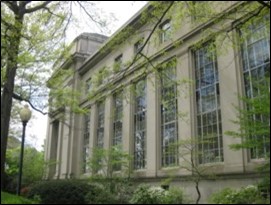Client: Massachusetts Institute of Technology
Reference Contact 1: MIT Facilities Program Manager
Reference Contact 2: Senior Project Manager, Department of MIT Facilities
Construction Budget: Phase I: $1.8 Million; Phase II: $12 Million
Masonry Preservation and Restoration
A stone-by-stone detailed analysis of the historic limestone façade was undertaken by Speweik Preservation Consultants (SPC) for the Main Group Building No. 2, ca. 1916 at Massachusetts Institute of Technology in Cambridge, Massachusetts. The building is three stories with 2 Pavilions, a ziggurat roof and over 32,500 square feet of façade limestone including the parapet walls. The types of stone include granite and Indiana Bedford limestone. A full and complete survey of the test panel (mock-down area 36’x36’x60’) was accomplished with supportive documentation, specifications and digital image reports provided.
Stone Masonry Restoration Training
Forensic investigation was used through the use of nondestructive testing equipment and techniques to understand the original mode of construction and the stresses that have developed in the wall system over time. Hands-on Historic Stone Masonry Training was developed by SPC using the framework of ASTM E2659-09. It was included in the scope to train the masons in the proper means and methods of application in regards to the recommended stone restoration treatments. Work scope and onsite training consisted of replacement, redress insitu, cleaning, substitute stone repair, DHL crack injections, Dutchman repair, remove and replace, and repointing mortar joints using lime putty mortar.
The project involvement consisted of existing materials analysis for matching procedures. Hand tools were fabricated by experienced stone masons from SPC in order to facilitate the correct specified approach. The project included long-term monitoring of the performance of the remediation and temperature and humidity monitors were installed in the test wall area to better understand the thermal and moisture conditions in the walls. The initial project started in April 2010 and was completed in February 2011. The limestone restoration program was completed in the fall of 2013.
The ASTM E2659-09 Historic Stone Masonry Training in Redress Insitu can be seen at: http://www.youtube.com/user/SpeweikPreservation#p/u/2/-tWSj6Ct9no


